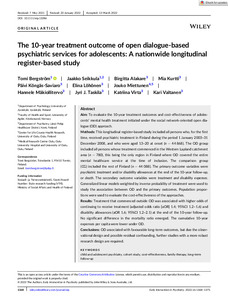The 10-year treatment outcome of open dialogue-based psychiatric services for adolescents : a nationwide longitudinal register-based study
Bergström, Tomi; Seikkula, Jaakko; Alakare, Birgitta; Kurtti, Mia; Köngäs-Saviaro, Päivi; Löhönen, Elina; Miettunen, Jouko; Mäkiollitervo, Hannele; Taskila, Jyri J.; Virta, Katriina; Valtanen, Kari (2022-03-25)
Bergström, T., Seikkula, J., Alakare, B., Kurtti, M., Köngäs-Saviaro, P., Löhönen, E., Miettunen, J., Mäkiollitervo, H., Taskila, J. J., Virta, K., & Valtanen, K. (2022). The 10-year treatment outcome of open dialogue-based psychiatric services for adolescents: A nationwide longitudinal register-based study. Early Intervention in Psychiatry, 16( 12), 1368– 1375. https://doi.org/10.1111/eip.13286
© 2022 The Authors. Early Intervention in Psychiatry published by John Wiley & Sons Australia, Ltd. This is an open access article under the terms of the Creative Commons Attribution License, which permits use, distribution and reproduction in any medium,provided the original work is properly cited.
https://creativecommons.org/licenses/by/4.0/
https://urn.fi/URN:NBN:fi-fe2023060151556
Tiivistelmä
Abstract
Aim: To evaluate the 10-year treatment outcomes and cost-effectiveness of adolescents’ mental health treatment initiated under the social network-oriented open dialogue (OD) approach.
Methods: This longitudinal register-based study included all persons who, for the first time, received psychiatric treatment in Finland during the period 1 January 2003–31 December 2008, and who were aged 13–20 at onset (n = 44 868). The OD group included all persons whose treatment commenced in the Western Lapland catchment area (n = 780), this being the only region in Finland where OD covered the entire mental healthcare service at the time of inclusion. The comparison group (CG) included the rest of Finland (n = 44 088). The primary outcome variables were psychiatric treatment and/or disability allowances at the end of the 10-year follow-up, or death. The secondary outcome variables were treatment and disability expenses. Generalized linear models weighted by inverse probability of treatment were used to study the association between OD and the primary outcomes. Population proportions were used to evaluate the cost-effectiveness of the approaches.
Results: Treatment that commenced outside OD was associated with higher odds of continuing to receive treatment (adjusted odds ratio [aOR] 1.4; 95%CI 1.2–1.6) and disability allowances (aOR 1.6; 95%CI 1.2–2.1) at the end of the 10-year follow-up. No significant difference in the mortality ratio emerged. The cumulative 10-year expenses per capita were lower under OD.
Conclusions: OD associated with favourable long-term outcomes, but due the observational design and possible residual confounding, further studies with a more robust research design are required.
Kokoelmat
- Avoin saatavuus [32523]

